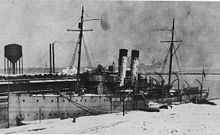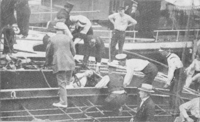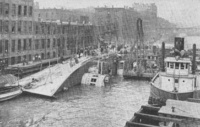SSEastland
 SSEastlandin Cleveland, Ohio (1911)
| |
| History | |
|---|---|
| Name | Eastland |
| Owner | Michigan Steamship Company |
| Route | South Haven, Michigan – Chicago, Illinois |
| Ordered | October 1902 |
| Builder | Jenks Ship Building Company |
| Launched | May 6, 1903 |
| Christened | May 1903 by Francis Elizabeth Stufflebeam |
| Maiden voyage | 16 July 1903 |
| Nickname(s) | "Speed queen of the Great Lakes" |
| Honors and awards |
|
| Fate | Sold during 1905 to the Michigan Transportation Company |
| Name | Eastland |
| Owner | Michigan Transportation Company |
| Operator | Chicago-South Haven Line |
| Route | South Haven – Chicago route |
| Fate | Sold 5 August 1906, to the Lake Shore Navigation Company of Cleveland, Ohio |
| Name | Eastland |
| Owner | Lake Shore Navigation Company of Cleveland, Ohio |
| Route | Cleveland-Cedar Point route |
| Fate | Sold during 1909 to the Eastland Navigation Company of Cleveland, Ohio |
| Name | Eastland |
| Owner | Eastland Navigation Company of Cleveland, Ohio |
| Route | Cleveland-Cedar Point route |
| Fate | Sold on 1 June 1914 to the St. Joseph-Chicago Steamship Company of St. Joseph, Michigan. |
| Name | Eastland |
| Owner | St. Joseph-Chicago Steamship Company of St. Joseph, Michigan |
| Route | St. Joseph, Michigan, to Chicago route |
| Fate | Raised after accident in October 1915 and sold at auction on 20 December 1915 to Captain Edward A. Evers, sold on 21 November 1917 to the IllinoisNaval Reserve. |
| Name | USSWilmette |
| Acquired | 21 November 1917 |
| Commissioned | 20 September 1918 |
| Recommissioned |
|
| Decommissioned |
|
| Renamed | Wilmetteon 20 February 1918 |
| Reclassified |
|
| Stricken | 19 December 1945 |
| Honors and awards |
|
| Fate | Sold for scrap on 31 October 1946 to Hyman Michaels Company of Chicago and scrapped, scrapping completed in 1947 |
| General characteristics | |
| Type | Passenger Ship |
| Tonnage | 1,961 gross |
| Displacement | 2,600 (estimated) |
| Length | 265 ft (81 m) |
| Beam | 38 ft 2 in (11.63 m) |
| Draft | 19 ft 6 in (5.94 m) |
| Installed power |
|
| Propulsion | Two shafts |
| Speed | 16.5 knots (30.6 km/h; 19.0 mph) |
| Capacity | AsEastland:2,752 passengers |
| Complement | As USSWilmette:209 |
| Armament |
|
| Notes |
|
SSEastlandwas a passenger ship based inChicagoand used for tours. On 24 July 1915, the ship rolled over onto its side while tied to a dock in theChicago River.[1]In total, 844 passengers and crew were killed in what was the largest loss of life from a single shipwreck on theGreat Lakes.[1][2]
After the disaster,Eastlandwas salvaged and sold to the United States Navy. After restorations and modifications,Eastlandwas designated agunboatand renamedUSSWilmette.She was used primarily as a training vessel on the Great Lakes, and was scrapped after World War II.
Construction
[edit]The ship was ordered during 1902 by the Michigan Steamship Company and built by the Jenks Ship Building Company ofPort Huron, Michigan.[3]The ship was named in May 1903, immediately before her inaugural voyage.
History
[edit]Early problems
[edit]On 27 July of her 1903 inaugural season, the ship struck the laid-up tugboatGeorge W. Gardner,which sank at its dock at the Lake Street Bridge in Chicago.Eastlandreceived only minor damage.[4][5]
Mutiny on theEastland
[edit]On 14 August 1903, while on a cruise from Chicago toSouth Haven, Michigan,six of the ship's firemen refused to stoke the fire for the ship's boiler, claiming that they had not received their potatoes for a meal.[4]When they refused to return to the fire hole, Captain John Pereue arrested the six men at gunpoint. Firemen George Lippen and Benjamin Myers, who were not a part of the group of six, stoked the fires until the ship reached harbor. Upon the ship's arrival in South Haven, the six men were taken to the town jail and charged withmutiny.Shortly thereafter, Captain Pereue was replaced.[4]
Speed modifications
[edit]Because the ship did not meet a targeted speed of 22 miles per hour (35 km/h; 19 kn) during her inaugural season and had adrafttoo deep for theBlack Riverin South Haven, Michigan, where she was being loaded, the ship returned in September 1903 to Port Huron for modifications, including the addition of an air-conditioning system, aninduced-draftsystem for the boilers to increase power, and repositioning of the ship's machinery to reduce the draft of the hull.[4][6][7]Even though the modifications increased the ship's speed, the reduced hull draft and extra weight mounted up high reduced themetacentric heightand inherent stability as originally designed.[6][7]

Listing incidents
[edit]Upon her return to South Haven in May 1904, the ship handily won a race to Chicago against theCity of South Haven.[6]In the meantime, theEastlandwas experiencing periodic problems with her stability while loading and unloading cargo and passengers, and nearly capsized on 17 July 1904 after leaving South Haven with about 3,000 passengers.[4][6]Subsequently, her capacity was lowered to 2,800 passengers, cabins were removed, lifeboats were added and the hull was repaired. On 5 August 1906, another listing incident occurred, which resulted in complaints filed against the Chicago-South Haven Line that had purchased the ship earlier that year.[6]
Before the 1907 season, the ship was sold to the Lake Shore Navigation Company and moved toLake Erie.[4]In 1909, the ship was sold again to the Eastland Navigation Company and continued running excursions between Cleveland andCedar Point.[6]After the 1909 season, the remaining 39 cabins were removed, and prior to the 1912 season, the top smokestack sections were removed to shorten her stack height.[6]On 1 July 1912, another incident occurred when theEastlandexperienced a severe listing of about 25° while loading passengers in Cleveland.[4][6]
In June 1914, theEastlandwas sold to the St. Joseph–Chicago Steamship Company and returned to Lake Michigan for St. Joseph, Michigan-to-Chicago service.[4]
TheEastlanddisaster
[edit]On 24 July 1915,Eastlandand four otherGreat Lakes passenger steamers—Theodore Roosevelt,Petoskey,Racine,andRochester—were chartered to take employees fromWestern ElectricCompany'sHawthorne WorksinCicero, Illinoisto a picnic inMichigan City, Indiana.[8][9]
The federalSeamen's Acthad been passed in 1915 following theRMSTitanicdisasterthree years earlier. The law required retrofitting of a complete set oflifeboatsonEastland,as on many other passenger vessels.[10]This additional weight may have madeEastlandmore dangerous by making her even more top-heavy. Some argued that other Great Lakes ships would suffer from the same problem,[10]but the bill was signed into law by PresidentWoodrow Wilson.Eastland's owners could choose to either maintain a reduced capacity or add lifeboats to increase capacity, and they elected to add lifeboats to qualify for a license to increase the ship's capacity to 2,570 passengers.[11]Eastlandwas already so top-heavy that she had special restrictions concerning the number of passengers that could be carried. In June 1914,Eastlandhad again changed ownership, this time bought by the St. Joseph and Chicago Steamship Company, with captain Harry Pederson appointed the ship's master. In 1914, the company removed the old hardwood flooring of the forward dining room on the cabin level and replaced it with 2 inches (51 mm) of concrete. It also added a layer of concrete near the aft gangway. This added 15–20 tons of weight.[12]

On the morning of 24 July, passengers began boardingEastlandon the south bank of the Chicago River betweenClarkandLaSalle Streetsat about 6:30 a.m., and by 7:10 a.m., the ship had reached her capacity of 2,572 passengers. Many passengers were standing on the open upper decks when the ship began to list slightly to the port side (away from the wharf). The crew attempted to stabilize the ship by admitting water into herballast tanks,but to little avail. At 7:28 a.m.,Eastlandlurched sharply to port and then rolled completely onto her port side, coming to rest on the river bottom, only 20 feet (6.1 m) below the surface; barely half of the vessel was submerged. Many passengers had already moved below decks on the cool and damp morning to warm themselves before the departure. Consequently, hundreds were trapped inside by the water and the sudden rollover, and some were crushed by heavy furniture, including pianos, bookcases and tables. The ship was only 20 feet (6.1 meters) from the wharf, and the crew of the nearby vesselKenosharesponded quickly by pulling alongside the hull to allow stranded passengers to leap to safety. However, 844 passengers and four crew members died. Many of the passengers onEastlandwere immigrants, with large numbers from present-day Czech Republic, Poland, Norway, Germany, Ireland, Sweden, Denmark, Italy, Hungary, and Austria.[13]Many of theCzechimmigrants had settled in Cicero; of the Czech passengers aboard, 220 perished in the disaster.[13]
The bodies were taken to temporary morgues established in the area for identification; by afternoon, the remaining unidentified bodies were consolidated in the armory of the 2nd Regiment.[8][14]
In the aftermath, theWestern Electric Companyprovided $100,000 (equivalent to $3.01 million in 2023)[15]to relief and recovery efforts of the family members of the victims.[16]
Among those scheduled to be onEastlandwas 20-year-oldfootballplayerGeorge Halas,later the coach and owner of theChicago Bearsand a founding member of theNational Football League,who was delayed leaving for the dock and arrived after the ship had overturned. Halas's name was listed on the list of deceased in newspapers, but he was later revealed to be unharmed. His friend and future Bears executiveRalph Brizzolaraand his brother were on theEastlandwhen she capsized but escaped through portholes.[17]Despite rumors to the contrary, entertainerJack Bennywas neither aboardEastlandnor scheduled for the excursion.
The first known film footage of the recovery efforts was discovered and released in 2015.[18]
Marion Eichholz, the last known survivor, died on 24 November 2014 at the age of 102.[19]
Media reports
[edit]WriterJack Woodfordwitnessed the disaster and offered a first-hand account to theHerald and Examiner.In his autobiography, Woodford wrote:
And then movement caught my eye. I looked across the river. As I watched in disoriented stupefaction a steamer large as an ocean liner slowly turned over on its side as though it were a whale going to take a nap. I didn't believe a huge steamer had done this before my eyes, lashed to a dock, in perfectly calm water, in excellent weather, with no explosion, no fire, nothing. I thought I had gone crazy.[citation needed]
Carl Sandburg,then known better as a journalist than as a poet, wrote an angry account forThe International Socialist Review,accusing regulators of ignoring safety issues and claiming that many of the workers were aboard following company orders for a mandatory staged picnic.[20]Sandburg also wrote a poem, "TheEastland",which contrasted the disaster with the mistreatment and poor health of the lower classes. Sandburg concluded the poem with a comparison:" I see a dozenEastlands/Every morning on my way to work/And a dozen more going home at night. "[21]The poem was considered too harsh for publication when written, but was eventually published in a collection of poems in 1993.[22]
Inquiry and indictments
[edit]Agrand juryindicted the president and three other officers of the steamship company formanslaughter,and the ship's captain and engineer forcriminal carelessness,and found that the disaster was caused by "conditions of instability" caused by overloading of passengers, mishandling of water ballast and the ship's faulty construction.[23]
During hearings regarding the extradition of the men to Illinois for trial, principal witness Sidney Jenks, president of the company that builtEastland,testified that her first owners wanted a fast ship to transport fruit, and he designed one capable of reaching 20 mph (32 km/h) and carrying 500 passengers. Defense counselClarence Darrowasked whether Jenks had ever concerned himself with the potential conversion of the ship into a passenger steamer with a capacity of 2,500 or more passengers. Jenks replied, "I had no way of knowing the quantity of its business after it left our yards... No, I did not worry about theEastland."Jenks testified that a stability test of the ship was never performed, and stated that after tilting to an angle of 45° at launching," it righted itself as straight as a church, satisfactorily demonstrating its stability. "[24]
The court refused extradition, holding that the evidence was too weak, with "barely a scintilla of proof" to establish probable cause to find the six guilty. The court reasoned that the four company officers were not aboard the ship, and that every act charged against the captain and engineer was performed in the ordinary course of business, "more consistent with innocence than with guilt." The court also reasoned thatEastland"was operated for years and carried thousands safely", and therefore the accused were justified in believing the ship to be seaworthy.[25]
Photo gallery
[edit]-
CartoonistBob Satterfieldwitnessed the capsizing from theClark Street Bridge,and sketched it for his syndicate
-
Passengers being rescued from the hull of theEastlandby a tugboat.
-
Victim recovered from theEastland
-
View ofEastlandfrom fire tug.
-
Eastlandbeing righted after the disaster.
-
View of the Eastland rescue underway. From a post card
-
Postcard of Eastland."The Ill Fated Eastland, which turned turtle in the Chicago River, July 24, 1915, at 7:30 A.M., causing the death of over 1000 persons, mostly women and children."
Second life as USSWilmette
[edit]
AfterEastlandwas raised on 14 August 1915, she was sold to the IllinoisNaval Reserveand recommissioned as USSWilmette,stationed at theNaval Station Great Lakes.She was converted to a gunboat, renamedWilmetteon 20 February 1918, and commissioned on 20 September 1918 under captain William B. Wells.[26]Commissioned late in World War I,Wilmettedid not experience combat. It trained sailors and experienced normal upkeep and repairs until placedin ordinaryat Chicago on 9 July 1919, retaining a 10-man caretaker crew aboard. On 29 June 1920, the gunboat was returned to full commission.[26]
On 7 June 1921,Wilmettewas tasked with sinkingUC-97,a German U-boat surrendered to the United States after World War I.[27]The guns ofWilmettewere manned bygunner's mateJ. O. Sabin, who had fired the first American cannon of World War I, and gunner's mate A. F. Anderson, the man who fired the first Americantorpedoof the war.[28]
For the remainder of her 25-year career, the gunboat served as a training ship for naval reservists of the 9th, 10th and 11th Naval Districts. It made voyages along the shores of the Great Lakes carrying trainees assigned to her from the Naval Station Great Lakes.Wilmettewas placed "out of commission, in service" on 15 February 1940.[26]
Given hull designation IX-29 on 17 February 1941, she resumed training duty at Chicago on 30 March 1942, preparing armed guard crews for duty manning the guns on armed merchantmen. That assignment continued until the end of World War II in Europe obviated measures to protect transatlantic merchant shipping from German U-boats.[26]
During August 1943,WilmettetransportedPresident Franklin D. Roosevelt,Admiral William D. Leahy,James F. ByrnesandHarry Hopkins[4]on a 10-day fishing vacation in McGregor andWhitefish Bay.[29]
On 9 April 1945, she was returned to full commission for a brief interval.Wilmettewas decommissioned on 28 November 1945, and her name was deleted from the Navy list on 19 December 1945. During 1946,Wilmettewas offered for sale, but on 31 October 1946, she was sold to the Hyman Michaels Company for scrapping, which was completed in 1947.[26]
Memorials
[edit]
A marker commemorating the accident was dedicated on 4 June 1989. This marker was reported stolen on 26 April 2000, and a replacement marker was installed and dedicated on 24 July 2003.
As of 2016[update],plans exist for a permanent outdoor exhibit with a proposed name of "At The River's Edge". This exhibit would be located along the portion of the Chicago Riverwalk adjacent to the site of the disaster and is planned to consist of panels with text and images.[30]
On 12 July 2015, 100 years after the disaster, a memorial to the dead was dedicated atBohemian National Cemeteryin Chicago.
In popular culture
[edit]The disaster was incorporated into the 1999 series premiere of theDisney Channeloriginal seriesSo Weird,in which teenage paranormal enthusiast Fiona Phillips encounters the ghost of a boy who drowned.[31]
In 2012, Chicago'sLookingglass Theatreproduced a musical entitledEastland: A New Musical,written by Andy White and scored byBen Collins-SussmanandAndre Pluess.[32][33]
TheEastlanddisaster is also pivotal to the story of one family told in the play/musicalFailure: A Love Story,written by Philip Dawkins, which premiered in Chicago in 2012 atVictory Gardens Theater.[34]The play premiered in Los Angeles on 24 July 2015, the 100th anniversary of the tragedy.[35]The play was again staged in Chicago at the Oil Lamp Theater and was nominated for multiple awards.[36]
In 2024, Chicago'sNeo-Futuristsproduced a puppetry show based on the disaster entitledSwitchboard.[37]
See also
[edit]Notes
[edit]- ^ab"The Eastland".Eastland Memorial Society. Archived fromthe originalon 24 March 2016.Retrieved25 April2009.
- ^Baillod, Brendon."Introduction".The Wreck of the Steamer Lady Elgin.Archived fromthe originalon 27 July 2015.Retrieved26 April2009.
- ^"Jenks Shipbuilding, Port Huron MI".Shipbuilding History.Archived fromthe originalon 8 October 2014.Retrieved26 June2014.
- ^abcdefghi"Eastland (1903)".Builder's Data and History.Maritime Quest.Archivedfrom the original on 16 February 2020.Retrieved10 May2020.
- ^"Annual report of the Supervising Inspector-general Steamboat-inspection Service, Year ending June 30, 1903".Washington: Government Printing Office. 1903. p. 75.Archivedfrom the original on 7 April 2022.Retrieved18 May2020– via Haithi Trust.
- ^abcdefgh"The Eastland – Early Life".Eastland Memorial Society. Archived fromthe originalon 19 January 2009.Retrieved10 May2020.
- ^abHilton, George (1995).Eastland: Legacy of the Titanic.Stanford University Press. pp. 41–43.ISBN0-8047-2801-1.
Whatever may have been the additional weight from the induced-draft and air-conditioning systems, it was enough to cause the ship tosquatwhen under way, promising to aggravate her chronic problem of striking bottom. To deal with the problem Wood undertook to relocate some of the ship's machinery. The exact nature of the repositioning was never stated, either at the time or after the disaster. Because the ship's machinery was quite limited, this probably meant some forward or aft movement of the engines and incidentally moving thecondensers.... The new induced-draft and air-conditioning systems, combined with Wood's repositioning of machinery to reduce her draft, however, produced a ship that was to prove chronically top-heavy.
- ^ab"Eastland Memorial Edition".Western Electric News. August 1915. Archived fromthe originalon 14 September 2011.Retrieved14 August2012.
- ^Hilton, George (1995).Eastland: Legacy of the Titanic.Stanford University Press. p. 93.ISBN0-8047-2801-1.
- ^ab"The Prophecy".The Eastland – Lake Erie.Eastland Memorial Society. Archived fromthe originalon 22 January 2009.Retrieved25 April2009.
- ^Bonansinga, Jay (2004).The Sinking of the Eastland: America's Forgotten Tragedy.Citadel Press. p. 52.ISBN0-8065-2628-9.
- ^Bonansinga (2004)[page needed]
- ^ab"The Passengers".Eastland Disaster Historical Society.2022.Archivedfrom the original on 25 September 2022.Retrieved24 September2022.
- ^"ITB: Eastland ghost stories".Chicago Bears.29 October 2013. Archived fromthe originalon 6 October 2014.Retrieved5 November2013.
He decided they needed to set up a consolidated, temporary morgue. They did at the 2nd Regiment Armory building, which later became the studios forOprah Winfrey.
- ^1634–1699:McCusker, J. J.(1997).How Much Is That in Real Money? A Historical Price Index for Use as a Deflator of Money Values in the Economy of the United States: Addenda et Corrigenda(PDF).American Antiquarian Society.1700–1799:McCusker, J. J.(1992).How Much Is That in Real Money? A Historical Price Index for Use as a Deflator of Money Values in the Economy of the United States(PDF).American Antiquarian Society.1800–present:Federal Reserve Bank of Minneapolis."Consumer Price Index (estimate) 1800–".Retrieved29 February2024.
- ^"Financial Relief".Eastland Disaster Historical Society.Retrieved2 August2024.
- ^"ITB: Halas escapes Eastland Disaster".Chicago Bears.29 October 2013. Archived fromthe originalon 13 December 2013.Retrieved5 November2013.
- ^Rodriguez, Meredith (8 February 2015)."First known film clips emerge of 1915 Eastland disaster".Chicago Tribune.Archivedfrom the original on 12 February 2015.Retrieved12 February2015.
- ^Manchir, Michelle (14 December 2014)."Last Survivor of 1915 Eastland Disaster Dies".Chicago Tribune.Archivedfrom the original on 14 December 2014.Retrieved14 December2014.
- ^Sandburg, Carl(September 1915)."Looking 'em over".The International Socialist Review.XVI(3): 132–137.
- ^Sandburg, Carl."Eastland".Archived fromthe originalon 23 June 2015.Retrieved9 July2015.
- ^Sandburg, Carl (1993). Hendrik, George; Hendrik, Willene (eds.).Billy Sunday and Other Poems.Harcourt Brace & Company. p. xiii.
- ^"Six Are Indicted for Eastland Loss – President of the Company, Captain, and Engineer Among Those Held for Disaster".The New York Times.11 August 1915.Archivedfrom the original on 5 March 2016.Retrieved12 February2017.
- ^"Eastland Never Tested – Builder of Ill-Fated Ship Says She Was Designed to Carry 500".The New York Times.23 January 1916.Archivedfrom the original on 5 March 2016.Retrieved12 February2017.
- ^"Nation Loses Point in Eastland Case; Court Refuses Application for Removal of Indicted Persons to Jurisdiction of Illinois".The New York Times.18 February 1916.Archivedfrom the original on 5 January 2024.Retrieved12 February2017.
- ^abcde"Wilmette".Dictionary of American Naval Fighting Ships.United States Navy.Archivedfrom the original on 7 August 2020.Retrieved26 April2009.
- ^"The UC-97".Eastland Disaster Historical Society. Archived fromthe originalon 10 August 2007.Retrieved26 April2009.
- ^"USS Wilmette".Eastland Memorial Society. Archived fromthe originalon 19 January 2009.Retrieved26 April2009.
- ^Mount, Graeme S. (July 2001)."Myths and Realities: FDR's Vacation on Lake Huron, 1–7 August 1943"(PDF).The Northern Mariner.XI(3): 23–32.doi:10.25071/2561-5467.600.S2CID247554079.Archived fromthe original(PDF)on 18 October 2023.
- ^"At The River's Edge A permanent outdoor Eastland Disaster exhibit".Eastland Disaster Historical Society. Archived fromthe originalon 9 October 2016.Retrieved29 January2016.
- ^AwesomeTVShows."So Weird 1x01 – Family Reunion".Dailymotion.Archivedfrom the original on 8 January 2015.Retrieved7 March2015.
- ^Ingram, Bruce (28 June 2012). "Musical Memorial for a Chicago Tragedy".Deerfield Review.Glenview, IL: Pioneer Press. pp. 98=B.
- ^Zoglin, Richard (27 June 2012)."Scandal in the Second City: Two Remarkable Shows From Chicago".Time.Archivedfrom the original on 6 March 2021.Retrieved7 September2020.
- ^"Failure: A Love Story*".Victory Gardens.23 July 2019.Archivedfrom the original on 28 August 2022.Retrieved28 August2022.
- ^Rohrer, Jason (24 July 2015)."Theater Review: FAILURE: A LOVE STORY (Coeurage Theatre Company at GTC in Burbank – Los Angeles)".stageandcinema.com.Archived fromthe originalon 28 July 2015.Retrieved22 March2018.
- ^"Failure: A Love Story".Oil Lamp Theater.Archived fromthe originalon 9 August 2022.Retrieved28 August2022.
- ^"SWITCHBOARD".The Neo-Futurist Theater.21 November 2023.Retrieved10 January2024.
References
[edit] This article incorporates text from thepublic domainDictionary of American Naval Fighting Ships.The entry can be foundhere.
This article incorporates text from thepublic domainDictionary of American Naval Fighting Ships.The entry can be foundhere.
Further reading
[edit]- Dial, Caitlyn Perry (2016).Only the River Remains: History and Memory of the Eastland Disaster in the Great Lakes Region, 1915 – 2015(PhD thesis). Western Michigan University.
- Green, Jocelyn (2022).Drawn By The Current.Bethany House Publishers.ISBN9780764233326.
- Kemp, Bill (20 July 2014)."Bloomington witness to Eastland disaster".The Pantagraph.Bloomington, IL.
- McCarthy, Michael (2014).Ashes Under Water: The SS Eastland and the Shipwreck that Shook America.Lyons Press.ISBN978-0762793280.
- Myers, Quinn (25 July 2019)."New Documentary Revisits Chicago's 'Deadliest Day'".WTTW.
- Wachholz, Ted (2005).The Eastland Disaster.Arcadia Publishing.ISBN0-7385-3441-2.
- Zett, Natalie (2021).Flower in the River.Zidova Publishing.ISBN978-1737579618.
External links
[edit]- Eastland Disaster Historical Society
- MaritimeQuest Eastland Photo Gallery
- Chicago Tribune Photographs
- 1903 ships
- Deaths due to shipwreck
- Disasters in Chicago
- Gunboats of the United States Navy
- 1910s in Chicago
- Maritime incidents in 1915
- Passenger ships of the United States
- Shipwrecks of Lake Michigan
- Steamships of the United States
- Steamships of the United States Navy
- Maritime incidents in the United States
- Ships built in Port Huron, Michigan







